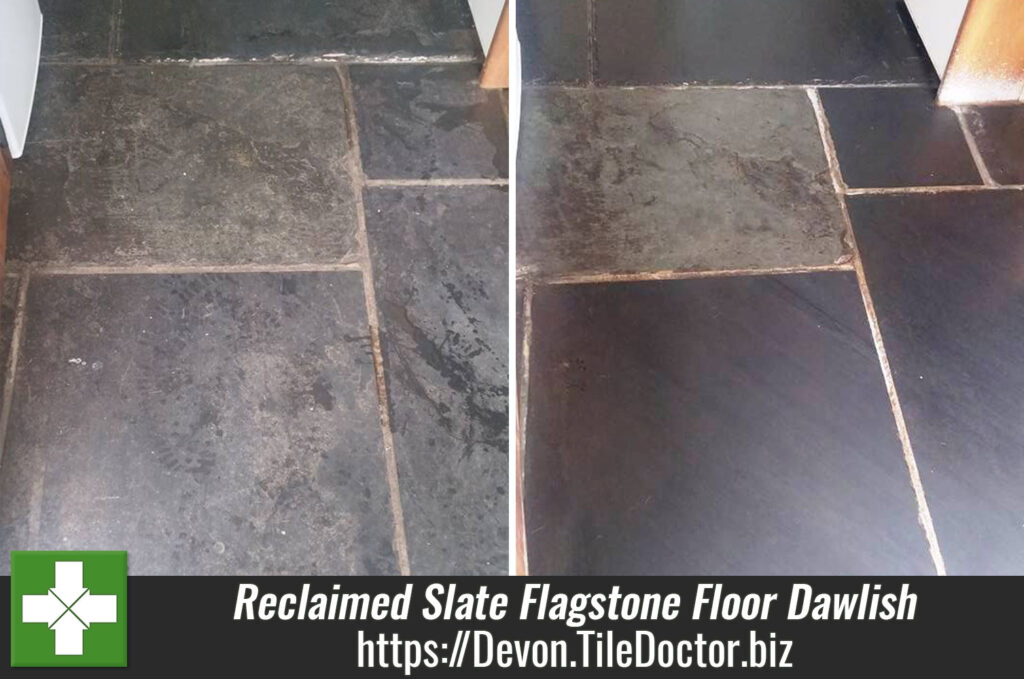Old Reclaimed Slate Flagstone Floor Rejuvenated in Dawlish
These lovely old Slate flagstones were reclaimed form an old waterworks in Exeter about twenty years ago and had been laid in an old fisherman cottage in Dawlish during a sympathetic renovation, replacing an old floor that had been laid in the 1970s (which have a lot to answer for with old houses!). The flagstones really looked the part and were larger and thicker than usually available on the market new. Other than being dirty and a pain to clean because of the dogs living in the house, around the edges of some of the larger tiles there was some sort of fluorescent orange residue which was up to 10mm thick in places and as hard as the stone it was adhered to.
Dawlish is a lovely little fishing harbour village on the South-East Cornwall coast with lots of interesting history. For hundreds of years the practice of smuggling imported goods prospered in the area thanks to its convenient harbour. The village is home to only around 5,000 inhabitants.
As you can see from the photo below, the tiles – along with the grout lines – were very dirty and stained. No wonder the property owner was beginning to give up on salvaging them! However, I assured the customer that with the right cleaning products and techniques, I could make a significant improvement to the condition of the floor.

Burnishing and Cleaning Old Slate Flagstones
To tackle the orange residue staining I used a grout removal tool which allowed the natural texture of the stone to remain rather than smoothing off the whole edge.
The dirt and staining in the slate flagstones however was so deeply ingrained I felt it best to strip back the affected layer of stone using a process known as burnishing. This involves the application of diamond encrusted burnishing pads to the floor, effectively grinding away the muck to reveal a cleaner surface beneath. When dealing with polished stone such as Limestone, Marble and Travertine, we will normally use a system of four burnishing pads – each with a different level of grit – to gradually restore the shine to the tiles.
However, in the case of these rustic, unpolished Slate Flagstones, I opted only to use only the Coarse and Medium grit burnishing pads to cut back the affected layer of stone, leaving a surface that could subsequently be scrubbed using Tile Doctor Remove and Go. This is a multi-purpose product that strips away any old sealer, adhesive marks and paint stains, while also cleaning the stone and grout.
This process ensured all traces of old sealer were removed and that the whole floor was left fresh and clean. The resulting soiled solution was extracted from the floor using a wet vacuum and the whole area rinsed with fresh water to remove any traces of cleaning product. To end the first day of work, the floor was left to dry overnight.
The village the cottage is situated in is very isolated to traffic; there is a car park at the top of the town and the only option is to walk the nearly half a mile each way to the cottage on the harbour so streamlining the kit used was a necessity! In the end two trips each way go the kit required there and back with the biggest machines being a wet vac and a rotary scrubber.
Sealing Old Slate Flagstones
Returning to the property the next day, I ran some damp tests to check if the floor was dry and ready to be sealed. This is particularly important in older properties like this, as it’s quite likely that there is no damp proof course present and moisture issues are far from uncommon.
Thankfully, the tiles proved dry and I could seal them using Tile Doctor Colour Grow. This impregnating, colour-enhancing sealer provides a robust seal, as well as a natural-look matte finish which really matches the character of these original Flagstones. It also really lifted the natural shades in the stone.

Professional Restoration of an Old Slate Flagstone Tiled Floor Devon
Old Reclaimed Slate Flagstone Floor Rejuvenated in Dawlish Read More »

